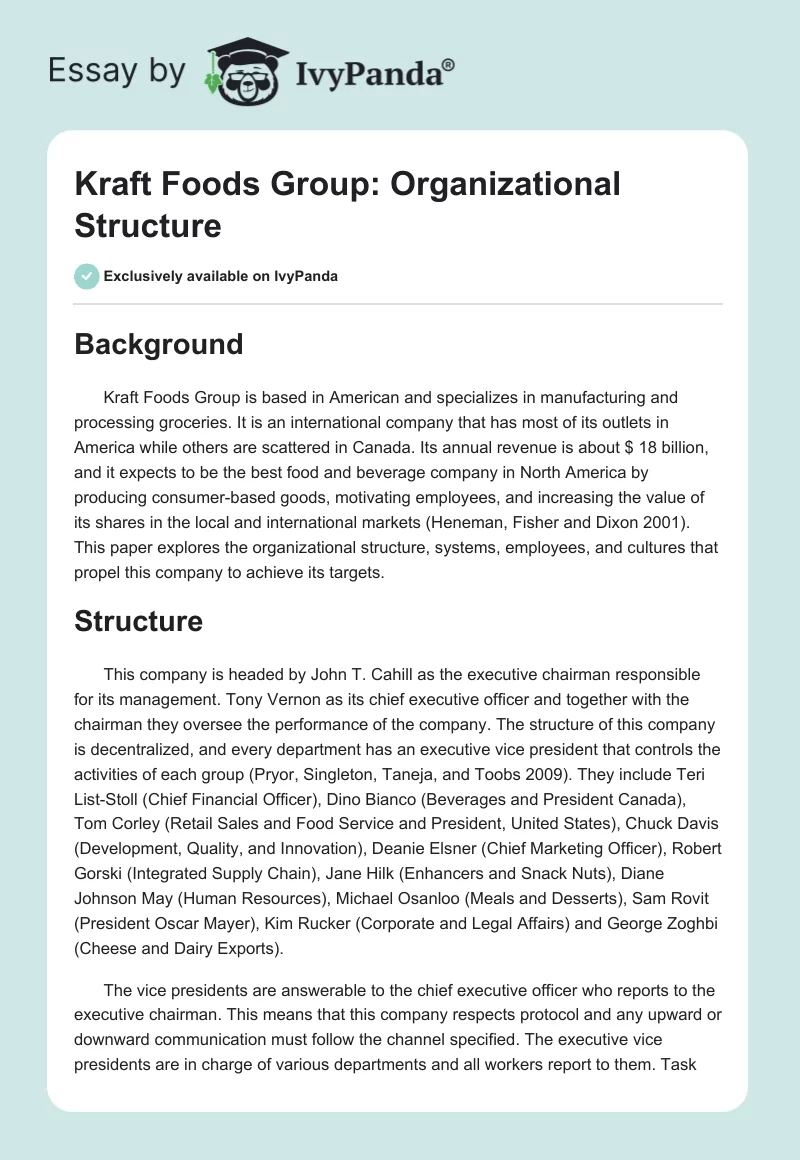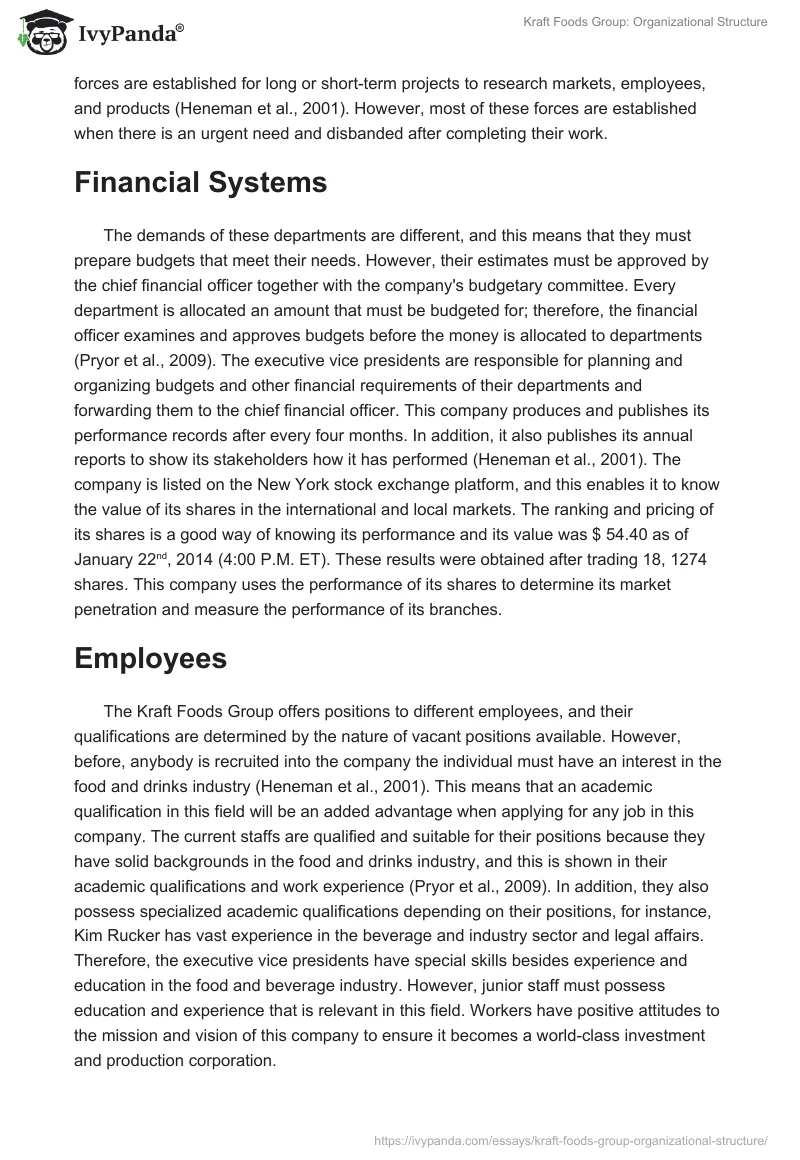Background
Kraft Foods Group is based in American and specializes in manufacturing and processing groceries. It is an international company that has most of its outlets in America while others are scattered in Canada. Its annual revenue is about $ 18 billion, and it expects to be the best food and beverage company in North America by producing consumer-based goods, motivating employees, and increasing the value of its shares in the local and international markets (Heneman, Fisher and Dixon 2001). This paper explores the organizational structure, systems, employees, and cultures that propel this company to achieve its targets.
Structure
This company is headed by John T. Cahill as the executive chairman responsible for its management. Tony Vernon as its chief executive officer and together with the chairman they oversee the performance of the company. The structure of this company is decentralized, and every department has an executive vice president that controls the activities of each group (Pryor, Singleton, Taneja, and Toobs 2009). They include Teri List-Stoll (Chief Financial Officer), Dino Bianco (Beverages and President Canada), Tom Corley (Retail Sales and Food Service and President, United States), Chuck Davis (Development, Quality, and Innovation), Deanie Elsner (Chief Marketing Officer), Robert Gorski (Integrated Supply Chain), Jane Hilk (Enhancers and Snack Nuts), Diane Johnson May (Human Resources), Michael Osanloo (Meals and Desserts), Sam Rovit (President Oscar Mayer), Kim Rucker (Corporate and Legal Affairs) and George Zoghbi (Cheese and Dairy Exports).
The vice presidents are answerable to the chief executive officer who reports to the executive chairman. This means that this company respects protocol and any upward or downward communication must follow the channel specified. The executive vice presidents are in charge of various departments and all workers report to them. Task forces are established for long or short-term projects to research markets, employees, and products (Heneman et al., 2001). However, most of these forces are established when there is an urgent need and disbanded after completing their work.
Financial Systems
The demands of these departments are different, and this means that they must prepare budgets that meet their needs. However, their estimates must be approved by the chief financial officer together with the company’s budgetary committee. Every department is allocated an amount that must be budgeted for; therefore, the financial officer examines and approves budgets before the money is allocated to departments (Pryor et al., 2009). The executive vice presidents are responsible for planning and organizing budgets and other financial requirements of their departments and forwarding them to the chief financial officer. This company produces and publishes its performance records after every four months. In addition, it also publishes its annual reports to show its stakeholders how it has performed (Heneman et al., 2001). The company is listed on the New York stock exchange platform, and this enables it to know the value of its shares in the international and local markets. The ranking and pricing of its shares is a good way of knowing its performance and its value was $ 54.40 as of January 22nd, 2014 (4:00 P.M. ET). These results were obtained after trading 18, 1274 shares. This company uses the performance of its shares to determine its market penetration and measure the performance of its branches.
Employees
The Kraft Foods Group offers positions to different employees, and their qualifications are determined by the nature of vacant positions available. However, before, anybody is recruited into the company the individual must have an interest in the food and drinks industry (Heneman et al., 2001). This means that an academic qualification in this field will be an added advantage when applying for any job in this company. The current staffs are qualified and suitable for their positions because they have solid backgrounds in the food and drinks industry, and this is shown in their academic qualifications and work experience (Pryor et al., 2009). In addition, they also possess specialized academic qualifications depending on their positions, for instance, Kim Rucker has vast experience in the beverage and industry sector and legal affairs. Therefore, the executive vice presidents have special skills besides experience and education in the food and beverage industry. However, junior staff must possess education and experience that is relevant in this field. Workers have positive attitudes to the mission and vision of this company to ensure it becomes a world-class investment and production corporation.
Culture
The culture of this company aims to achieve seven key aspects that are important in ensuring that it promotes healthy lifestyles, reduces environmental impacts, and achieves excellent financial performance (Garrow and Hirsh 2008). This company ensures that its employees work in safe environments. In addition, it promotes wellness by offering quality services to its employees to meet their requirements. It offers equal opportunities to qualified individuals from different backgrounds to be its employees so that it can have the experience of its customers through its workers (Heneman et al., 2001). The most significant symbols of this company include compliance, nutrition, culture, community, and safety that are all painted green to reflect its sustainability and environmental conservation policies.
This company uses the people-centered management style that puts the interests of consumers first and respects their needs (Garrow and Hirsh 2008). In addition, it values its employees because they are the engine of this company. Conflicts are resolved within units, and every department has a human resource section that addresses queries from employees and customers.
References
Garrow, V. and Hirsh, W. (2008). Talent management: Issues of focus and fit. Public Personnel Management, 37(4), 389-403. Web.
Heneman, R. L., Fisher, M. M., and Dixon, K. E. (2001). Reward and organizational systems alignment: An expert system. Compensation and Benefits Review, 33(6), 18-29. Web.
Pryor, M. G, Singleton, L. P., Taneja, S. and Toobs, L. A. (2009). Teaming as a strategic and tactical tool: An analysis with recommendations. International Journal of Management, 26 (2), 320-334. Web.


